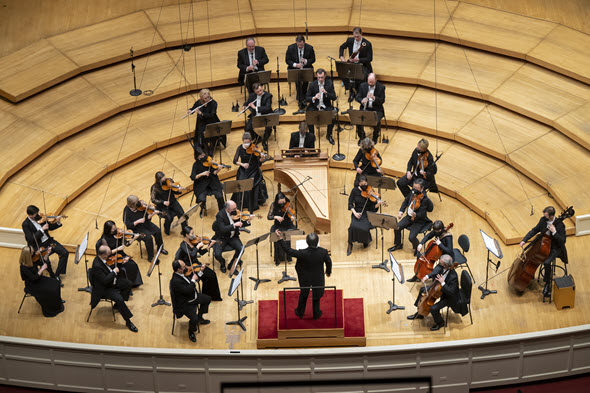Going for Baroque from opposite directions: Different worlds echoed in CSO, Apollo’s Fire
By Lawrence B. Johnson
Review: Chicago Symphony Orchestra conducted by Riccardo Muti; Apollo’s Fire conducted by Jeannette Sorrell.
The celebrated harpsichordist Wanda Landowska famously ended a dispute about performance style by declaring: “You play Bach your way and I shall play Bach his way.” That supremely confident pronouncement came well before the idea of Historically Informed Performance ever entered the conversation.
I thought of Landowska after a late-January sequence of Baroque concerts by the Chicago Symphony Orchestra conducted by music director Riccardo Muti and a few days later the Cleveland-based band Apollo’s Fire, which specializes in early 18th-century music, with its founder and longtime leader Jeannette Sorrell. The musical results, while quite polished in both cases, could not have been more dissimilar in their fundamental approach to works by Vivaldi (represented on both programs) or, more broadly, Handel in Muti’s hands and Bach in Sorrell’s.
But a third recent event also came to mind: the Chicago Symphony’s December offering of Handel’s “Messiah” under another certified practitioner of 18th-century music, Nicholas McGegan. He figures into this discussion as perhaps reflecting the modern ideal of Baroque performance as crisp, brisk, unmannered and unfussy. Indeed, McGegan drew from the Chicago Symphony Chorus the same stylistic profile he elicited from the small cadre of CSO instrumentalists. It was, to my mind, exemplary Baroque style, as spirited and as it was thoroughly considered.
To call Muti’s choice of Baroque repertoire surprising would be drastic understatement. While unquestionably one of the foremost orchestra conductors of the last half century, Muti has no particular reputation in the Baroque repertoire; thus, the prospect of three Vivaldi concertos and the first suite from Handel’s “Water Music” incited not so much anticipation as curiosity. The event turned out to be what one might have expected: efficient, musically solid and unremarkable. Truly, I can’t recall ever before having walked away from a Muti-CSO performance with a shrug. I couldn’t help thinking of McGegan’s wonderful “Messiah,” and how far short this diversion fell from that.
The two Vivaldi concertos featuring members of the CSO were polished and disciplined – the first for violinists Robert Chen, Stephanie Jeong, David Taylor and Yuan-Qing Yu, and the second spotlighting principal flute Stefán Ragnar Höskuldsson. It’s always a pleasure to hear these virtuoso musicians step forward – rather like being in the room with a great singer, even if it’s only to delight at the sound of vocal exercises. But I found both concertos to be too contained and straight-forward, and the sound too much indebted to the lineage of Schubert and Bruckner. I didn’t hear the edge, the rhythmic bounce of music before Mozart.
That disappointment was mild compared with the effect of Muti’s measured tread through Handel’s “Water Music.” It was as if conductor and musicians alike were all sitting back instead of leaning forward. Here were all the familiar tunes, quite resonant and beautiful, but nearly devoid of drive, vibrancy, animation. Across town, those very qualities were to rule in over-the-top amplitude at the concert by Apollo’s Fire and its indeed fiery leader Sorrell.
The Cleveland ensemble’s concert at the Music Institute of Chicago, in Evanston, marked the beginning of a projected annual Chicago series. This program, divided between Vivaldi and Bach, attested to a highly skilled, energetic little troupe of musicians who play standing, even if they don’t stand in one spot for very long. Sorrell’s lively tempos kept the band on its toes – and I might as well say rockin’ to the rhythms of those old boys from Venice and Leipzig.
A propulsive turn through Bach’s “Brandenburg” Concerto No. 3 in G served as preface to the main Bach event: a reconstruction of his Violin Concerto in D minor, a prodigious work reforged from the Keyboard Concerto in D minor. Actually, the concerto was originally written for violin, then transcribed by Bach for keyboard; but the violin version was subsequently lost. Spanish violinist Francisco Fullana dispatched this grand-scaled essay with heady virtuosity – tossing in a formidable, blazing first-movement cadenza worthy of Paganini. It was an electric performance, even if on the wild side of Baroque fashion.
Throughout the concert, Sorrell pushed the Baroque boundaries in a determined effort to recapture the music in all the freshness of its native sound. Here was highly idiosyncratic music-making, with persistent lifts at phrase endings, ever-buoyant rhythms and generally quick tempos. No solemn enshrinement here, no deference before the some pale plaster bust. This was Bach perceived as youthful and headstrong.
If anything, Sorrell’s take on two Vivaldi concertos, respectively for two cellos and for two violins, was even more extreme – arguably to the point of mannerism. (As in everything else on her program, she led both concertos while standing at a two-manual harpsichord.) It’s a little hard to imagine the young residents of the Venice school for orphan girls, for whom Vivaldi wrote these pieces, tossing them off with such heady abandon. But who knows, maybe they did. My quibble notwithstanding, both concertos were not only expertly played, but they were also great fun. The intimate space rang with musical joy and mirth. That, beyond question, was the original idea.






